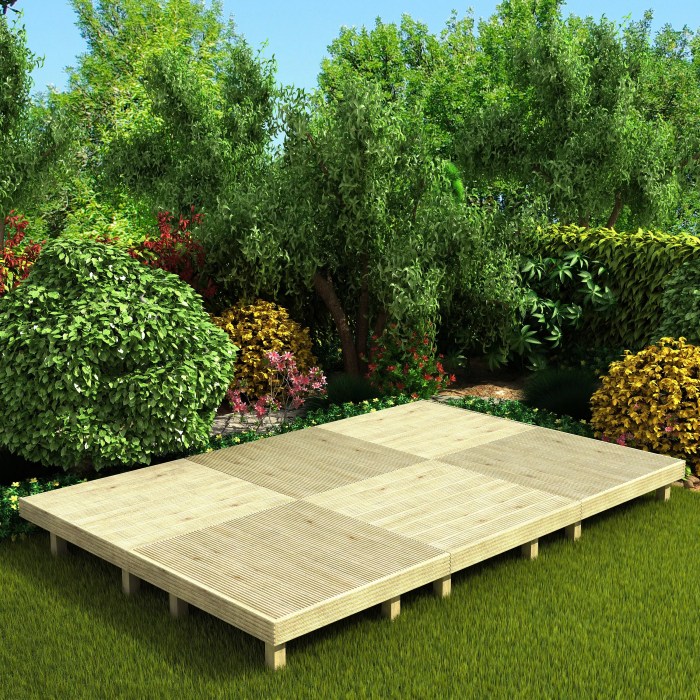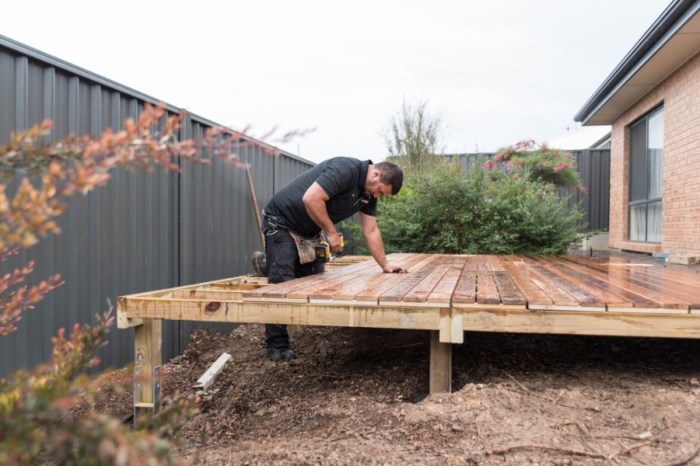DIY decking kits have revolutionized the way homeowners create beautiful and functional outdoor spaces. These kits offer a convenient and cost-effective solution for building decks, patios, and balconies, allowing individuals to take control of their projects and personalize their outdoor living areas. Whether you’re a seasoned DIY enthusiast or a first-time builder, decking kits provide a structured approach to deck construction, simplifying the process and ensuring a successful outcome.
The benefits of using DIY decking kits are numerous. They offer pre-cut and pre-drilled components, reducing the need for extensive cutting and measuring. The kits typically include detailed instructions and diagrams, making the installation process straightforward. Moreover, DIY decking kits often come with warranties, providing peace of mind and ensuring the quality of the materials.
Introduction to DIY Decking Kits
DIY decking kits are pre-packaged sets of materials and instructions designed to help homeowners build their own decks. These kits typically include everything needed for a basic deck, including lumber, fasteners, and hardware. They can be a great way to save money and add value to your home.
DIY decking kits are a relatively new development in the home improvement industry. The first kits appeared in the 1990s, and they have become increasingly popular in recent years. This popularity is due in part to the increasing number of homeowners who are looking for ways to save money and add value to their homes.
Benefits of DIY Decking Kits
DIY decking kits offer a number of benefits over traditional decking construction methods.
- Cost savings: DIY decking kits are typically less expensive than hiring a contractor to build a deck. This is because you are only paying for the materials and not for the labor.
- Convenience: DIY decking kits come with everything you need to build a deck, including the instructions. This makes the process much easier and more convenient than trying to source all of the materials yourself.
- Customization: DIY decking kits are available in a variety of sizes and styles, so you can choose the perfect one for your home. You can also customize the deck to your liking by adding features such as railings, steps, and lighting.
History of DIY Decking Kits
The idea of DIY decking kits was born out of the growing trend of homeowners taking on more home improvement projects themselves. In the early days, DIY decking kits were simple and basic, often consisting of just lumber and instructions. However, as the popularity of these kits grew, manufacturers began to offer more sophisticated kits with a wider range of features and options.
The evolution of DIY decking kits has been driven by a number of factors, including the increasing demand for affordable and convenient home improvement solutions, the development of new materials and technologies, and the growing popularity of online shopping.
Types of DIY Decking Kits

DIY decking kits are available in a variety of materials, each with its own set of pros and cons. The most common types of decking kits are made from wood, composite, and PVC.
Wood Decking Kits
Wood decking kits are the most traditional type of decking kit. They are made from natural materials, which gives them a classic look and feel. Wood decking kits are also relatively affordable, making them a popular choice for budget-conscious homeowners.
Here are some of the pros and cons of wood decking kits:
- Pros:
- Natural and classic look
- Affordable
- Easy to work with
- Cons:
- Requires regular maintenance, such as staining and sealing
- Susceptible to rot, decay, and insect damage
- Can be slippery when wet
Some popular brands of wood decking kits include:
- Trex
- TimberTech
- Azek
Composite Decking Kits
Composite decking kits are made from a blend of wood fibers and recycled plastic. This makes them more durable and low-maintenance than traditional wood decking. Composite decking kits are also available in a wide variety of colors and styles, making them a good choice for homeowners who want a modern look.
Here are some of the pros and cons of composite decking kits:
- Pros:
- Durable and long-lasting
- Low-maintenance
- Available in a variety of colors and styles
- Cons:
- More expensive than wood decking
- Can be susceptible to fading in direct sunlight
- May not be as environmentally friendly as wood decking
Some popular brands of composite decking kits include:
- Trex
- TimberTech
- Azek
PVC Decking Kits
PVC decking kits are made from polyvinyl chloride, a type of plastic. PVC decking kits are very durable and low-maintenance. They are also resistant to rot, decay, and insect damage. PVC decking kits are a good choice for homeowners who want a decking material that will last for many years.
Here are some of the pros and cons of PVC decking kits:
- Pros:
- Very durable and long-lasting
- Low-maintenance
- Resistant to rot, decay, and insect damage
- Cons:
- More expensive than wood or composite decking
- Can be susceptible to fading in direct sunlight
- May not be as environmentally friendly as wood decking
Some popular brands of PVC decking kits include:
- Azek
- Fiberon
- DuraLife
Choosing the Right DIY Decking Kit
Choosing the right DIY decking kit is crucial for a successful project. It’s important to consider several factors to ensure you select a kit that meets your needs and budget.
Factors to Consider When Choosing a DIY Decking Kit, Diy decking kits
- Size: The size of your decking project will determine the amount of material you need. Consider the dimensions of your deck, including the length, width, and height.
- Material: DIY decking kits are available in various materials, such as wood, composite, and PVC. Each material has its own advantages and disadvantages.
- Wood is a natural material that is affordable and easy to work with. However, it requires regular maintenance to prevent rot and insect damage.
- Composite decking is a blend of wood fibers and plastic, making it more durable and low-maintenance than wood. It is also resistant to rot and insects.
- PVC decking is a synthetic material that is highly durable, low-maintenance, and resistant to moisture, insects, and fading. It is also available in a wide range of colors.
- Style: The style of your deck should complement your home’s architecture. DIY decking kits come in various styles, including traditional, modern, and contemporary.
- Budget: The cost of DIY decking kits varies depending on the material, size, and features. Set a budget before you start shopping to help you narrow down your options.
Comparing Different Decking Kit Features and Specifications
Here’s a table comparing different decking kit features and specifications:
| Feature | Wood Decking Kit | Composite Decking Kit | PVC Decking Kit |
|---|---|---|---|
| Material | Wood | Wood fibers and plastic | PVC |
| Durability | Moderate | High | Very high |
| Maintenance | High | Low | Very low |
| Cost | Affordable | Moderate | High |
| Style Options | Wide variety | Limited | Limited |
Choosing the Right DIY Decking Kit for Your Project
Here’s a step-by-step guide to help you choose the appropriate DIY decking kit for your specific project:
- Determine the size of your deck. Measure the length, width, and height of your desired deck area.
- Consider your budget. Set a budget for your decking project, taking into account the cost of the kit, tools, and labor (if you’re hiring someone to help).
- Decide on the material. Choose a material that meets your needs and budget. Consider the durability, maintenance requirements, and style options of each material.
- Research different DIY decking kit brands and models. Compare features, specifications, and prices to find a kit that meets your requirements.
- Read reviews from other customers. This can help you get a better understanding of the quality and performance of different DIY decking kits.
- Purchase your kit. Once you’ve chosen a kit, purchase it from a reputable retailer. Make sure the kit includes all the necessary components, including the decking boards, joists, fasteners, and instructions.
Maintenance and Care of DIY Decking: Diy Decking Kits

Just like any other outdoor structure, your DIY decking needs regular maintenance to keep it looking its best and lasting for years to come. This involves a few key steps: cleaning, sealing, and addressing any repairs.
Cleaning DIY Decking
Cleaning your DIY decking is essential for removing dirt, debris, and stains that can build up over time. Regular cleaning helps to prevent the growth of mold and mildew, which can damage the wood and make it slippery.
- Sweep or brush the decking regularly to remove loose debris like leaves, twigs, and dirt.
- Use a mild detergent solution mixed with water to clean the decking. Avoid harsh chemicals or abrasive cleaners that can damage the wood.
- Rinse the decking thoroughly with clean water after cleaning. Allow the decking to dry completely before applying any sealant.
Sealing DIY Decking
Sealing your DIY decking is crucial for protecting it from the elements, such as rain, sun, and snow. A sealant helps to prevent water damage, fading, and cracking.
- Apply a sealant to your decking every 1-2 years, depending on the type of wood and the climate you live in.
- Choose a sealant that is specifically designed for outdoor use and is compatible with the type of wood you used for your decking.
- Follow the manufacturer’s instructions carefully when applying the sealant.
Repairing DIY Decking
Over time, your DIY decking may require repairs, such as replacing damaged boards or fixing loose screws. Addressing these issues promptly can help to prevent further damage and extend the life of your decking.
- Replace any damaged or rotten boards with new ones. Make sure to use screws that are long enough to penetrate the joists and provide secure support.
- Tighten any loose screws or nails. If the screws are stripped, you may need to replace them with new ones.
- Use wood filler to repair any cracks or holes in the decking boards.
Building a deck with a DIY kit can be a rewarding experience, allowing you to create a personalized outdoor space that complements your home and lifestyle. With careful planning, attention to detail, and a bit of elbow grease, you can transform your backyard into a haven for relaxation, entertaining, and enjoying the outdoors. Whether you choose a classic wood deck, a low-maintenance composite option, or a durable PVC design, DIY decking kits provide a versatile and accessible way to bring your outdoor dreams to life.
DIY decking kits offer a fantastic way to create your dream outdoor space, whether it’s a cozy patio or a spacious deck. While building a deck can be a rewarding project, it’s important to remember that even simple tasks can sometimes lead to unexpected challenges. Just like understanding the complexities of mesalamine for specific health conditions, tackling a DIY project requires careful planning and research.
By following the instructions carefully and seeking professional advice when needed, you can ensure a successful and enjoyable decking experience.
